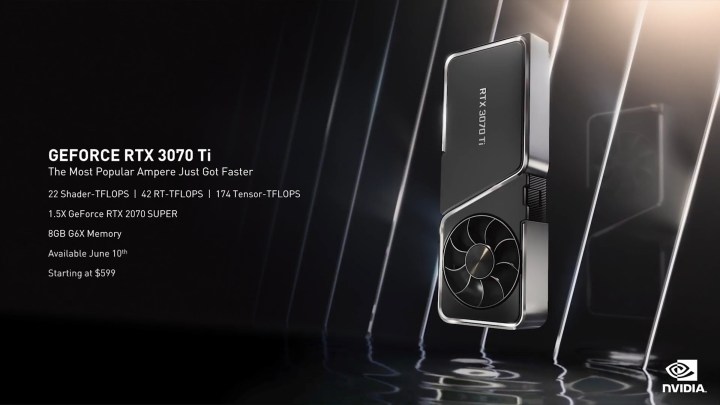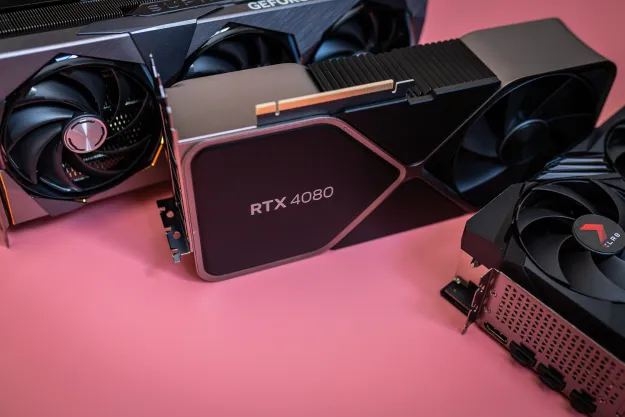Nvidia released a 12GB variant of the RTX 3080 this morning. On Monday, we heard about Nvidia potentially launching this card, but I didn’t pay it much mind — after all, Nvidia just announced two new graphics cards at CES, and it didn’t make sense to further segment an already granular lineup of GPUs.
But the 12GB RTX 3080 is here, at least in spirit. It’s a marginal upgrade over the base model, featuring 2GB more of GDDR6X video memory, a 3% bump in core count, and a 9% increase in power draw. It’s as marginal as upgrades come, despite coming with somewhere around a 50% price increase.
We have a check for these types of products — independent reviews. But there aren’t any 12GB RTX 3080 reviews on launch day, the only day where you’ll be able to get a card at a decent price, and that’s a worrying sign for the graphics cards in 2022.
Playing devil’s advocate

The main question tickling the back of my head, and I’m sure many of yours, is: Why? Why release a slight upgrade to a graphics card that’s a year and a half old after announcing two new graphics cards at CES a week ago? Before getting to the disaster that is the 12GB RTX 3080 launch, it’s important to at least consider what Nvidia was trying to accomplish.
The GPU shortage has created a tough situation for AMD and Nvidia. List prices mean effectively nothing, hype draws in droves of profit-focused customers, and paper launches have become the norm. I’m giving Nvidia credit here — don’t worry, there’s plenty of criticism to come — but it’s still important to understand this situation from Nvidia’s perspective.
Nvidia hasn’t set a list price for the 12GB RTX 3080, which is a good thing. Add-in board partners (AIBs) like MSI, EVGA, and Gigabyte are the ones that ultimately bear the cost of manufacturing, and in a time when component prices are determined by the whim of the supply chain, a list price only serves as an inaccurate marketing touchstone.

For hype, it’s possible that Nvidia left the 12GB RTX 3080 off the CES stage to deter some attention from scalpers. By silently launching it, the hope seems to gather the attention of in-tune gamers who have been searching for graphics cards without broadcasting the release to a drove of bots.
There are some possible justifications to how Nvidia rolled out the 12GB RTX 3080. But they don’t seem likely given how many other issues there are with the 12GB RTX 3080 launch.
Why there aren’t 12GB RTX 3080 reviews

I could twist my arm behind my back trying to justify how Nvidia launched the 12GB RTX 3080, but it’s hard to defend Nvidia because of two key problems: Press didn’t have access to a driver for day one reviews, and the limited prices I’ve seen are far and above what the 12GB RTX 3080 should cost.
Hardware Unboxed shared that Nvidia wouldn’t offer a press driver ahead of launch. Moore’s Law is Dead, a YouTube channel focused on GPU and CPU leaks, also shared that Nvidia wasn’t distributing the driver to anyone. I’ve reached out to Nvidia for clarification, and I’ll update this story when I hear back. But even without official word, the lack of day-one reviews suggests that no one had access to the driver.
There aren’t any 12GB RTX 3080 reviews, at least on launch day. Like the 12GB RTX 2060, Nvidia announced this new model through a driver release — the same day that anyone with pre-release access to the card could download the driver. Embargoes, deadlines, and press drivers aren’t important, though: What’s important is that no one knows how the 12GB RTX 3080 performs on launch day, which is the only day for many months that you’ll be able to get a card for a reasonable price.
Erm, or at least a semi-reasonable price. That’s the other problem with the 12GB RTX 3080. Nvidia hasn’t set a list price, and early signs aren’t promising. Take EVGA’s 12GB RTX 3080 XC3 Ultra. The company has the card listed — of course, out of stock — for $1,249. That’s $40 more expensive than the same model of the RTX 3080 Ti.

Keep in mind that the RTX 3080 launched as a $699 graphics card originally. While $1,249 may not seem too bad given the secondhand prices of 10GB RTX 3080 models, it’s downright insulting to charge such a high premium for such a marginal update. The GPU pricing crisis will wane, but the inflated list price of the 12GB RTX 3080 will remain.
A bad omen for 2022

Nvidia isn’t off to the best start this year. After a hopeful showing of budget GPUs at CES 2022, I’m disappointed by the 12GB RTX 3080 launch. Of course, I’m disappointed that precious few people will be able to secure a unit, but moreover, I’m disappointed by the tone it sets for Nvidia this year.
At the end of 2021, Nvidia did a silent launch for the 12GB RTX 2060 — no big press release, no list price, and no Founder’s model. It made sense then for a last-gen card that wasn’t ever meant to capture the limelight. For a new flagship, this type of silent launch is, at best, worrying.
I’d like to play devil’s advocate and say that Nvidia quietly released the 12GB RTX 3080 to limit demand from scalpers and bring the cost of manufacturing down to reality. But I can’t, given how much else is wrong with this launch. Prices are way higher than they should be, even before scalpers have a chance to inflate them, and the limited number of reviews creates a confusing situation where no one is clear how the card performs on launch day.
Editors' Recommendations
- Nvidia could flip the script on the RTX 5090
- These early RTX 4080 Super listings confirmed my worries about the GPU
- Nvidia did the unthinkable with the RTX 4080 Super
- How I conceded to the RTX 4060 Ti
- This might be why the RTX 4090 is getting so expensive




